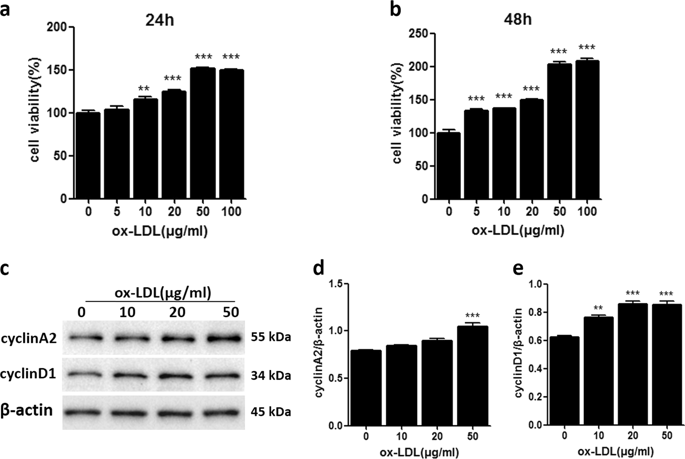Cell Death Discovery ( IF 6.1 ) Pub Date : 2019-07-05 , DOI: 10.1038/s41420-019-0196-0 Zhenzhen Sun , Yuanyuan Li , Yun Qian , Mengying Wu , Songming Huang , Aihua Zhang , Yue Zhang , Zhanjun Jia

|
Mesangial cell (MC) proliferation is one of the important pathological features of obesity-associated nephropathy with unknown etiology. Excessive MC proliferation can cause glomerulosclerosis and renal function loss. Thus, targeting MC proliferation may be a potential strategy for the treatment of obesity-associated kidney disease. The present study was undertaken to investigate the role of celastrol in MC proliferation induced by ox-LDL, as well as the potential mechanisms. Following ox-LDL treatment, MC proliferation was induced and the NLRP3 inflammasome was activated, as evidenced by increased NLRP3 levels, caspase 1 activity, and IL-18 and IL-1β release. Significantly, NLRP3 siRNAs inhibited MC proliferation and delayed cell cycle progression, as indicated by the cell cycle assay and the expression of cyclin A2 and cyclin D1. Given the anti-inflammatory effect of celastrol, we pretreated MCs with celastrol before ox-LDL treatment. As expected, celastrol pretreatment strikingly inhibited NLRP3 inflammasome activation and MC proliferation triggered by ox-LDL. In summary, celastrol potently blocked ox-LDL-induced MC proliferation, possibly by inhibiting NLRP3 inflammasome activation. These findings also suggest that celastrol may be a potential drug for treating proliferative glomerular diseases related to obesity and lipid disorders.
中文翻译:

Celastrol通过抑制NLRP3炎性体激活来减弱ox-LDL诱导的系膜细胞增殖
肾小球系膜细胞(MC)增殖是病因不明的肥胖相关性肾病的重要病理特征之一。MC过度增殖可引起肾小球硬化和肾功能丧失。因此,靶向MC增殖可能是治疗与肥胖相关的肾脏疾病的潜在策略。本研究旨在研究Celastrol在ox-LDL诱导的MC增殖中的作用以及潜在的机制。ox-LDL处理后,诱导了MC增殖,并激活了NLRP3炎性小体,这可以通过增加NLRP3水平,胱天蛋白酶1活性以及IL-18和IL-1β释放来证明。值得注意的是,NLRP3 siRNA抑制MC增殖并延迟细胞周期进程,如细胞周期测定以及细胞周期蛋白A2和细胞周期蛋白D1的表达所表明的。鉴于Celastrol的抗炎作用,我们在ox-LDL治疗之前先用Celastrol预处理MC。如预期的那样,Celastrol预处理显着抑制了ox-LDL触发的NLRP3炎性小体激活和MC增殖。总之,celastrol可能通过抑制NLRP3炎性体的活化来有效地阻断ox-LDL诱导的MC增殖。这些发现还表明,Celastrol可能是治疗与肥胖症和脂质疾病有关的增生性肾小球疾病的潜在药物。可能是通过抑制NLRP3炎性体的活化来实现的。这些发现还表明,Celastrol可能是治疗与肥胖症和脂质疾病有关的增生性肾小球疾病的潜在药物。可能是通过抑制NLRP3炎性体的活化来实现的。这些发现还表明,Celastrol可能是治疗与肥胖症和脂质疾病有关的增生性肾小球疾病的潜在药物。











































 京公网安备 11010802027423号
京公网安备 11010802027423号